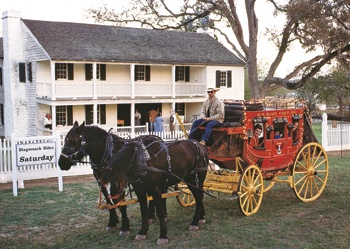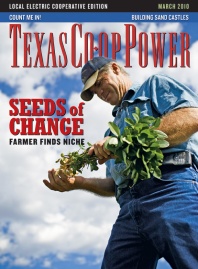With the fast clatter of horses’ hooves, our stagecoach swings into the driveway of the Fanthorp Inn State Historic Site in Anderson, near Bryan-College Station. We step down out of the cherry-red reproduction 1850s coach and walk toward the whitewashed clapboard inn. Although its rooms are silent now, it is easy to imagine the flurry of activity in the early days of Texas travel as stagecoach passengers arrived for the night.
In 1834, English immigrant Henry Fanthorp built this dogtrot cedar log cabin—later expanded into a two-story clapboard inn—for his young wife, Rachel. After he was appointed postmaster, weary travelers arrived by stagecoach along with the mail and slept on pallets on the floor. He added a second floor in 1846, and in 1850, the structure officially became an inn with rooms to rent.
A popular stagecoach stop on a busy east-west highway, the Fanthorp Inn attracted such notable guests as Sam Houston, Anson Jones, Zachary Taylor and Robert E. Lee. Although Anderson is a sleepy town today with about 280 residents, it was the fourth largest town in Texas during the fast-forward period from the Republic era through statehood and the Confederacy. “Whether you were coming by land (from Nacogdoches) or sea (from Galveston), you came through Anderson,” says historic site manager John Lindon. “That crossroads was so important that a town sprung up here.”
Travelers arrived exhausted and hungry after a long day of lurching over muddy, potholed roads. A stagecoach could cover 15 to 20 miles a day; when it got stuck in knee-deep mud, second-class passengers had to climb down from the roof and push. For $1.50 a night, guests received a bed and meals. At a time when most inns served a ubiquitous corn gruel punctuated with bits of pork or wild game, the Fanthorp was known for its high-quality food. Supper usually consisted of beef or pork with mashed potatoes or grits, peas or beans, cornbread to sop up the gravy and sweet potato or apple pie. Men were encouraged to smoke during the meal to keep bugs away, and a servant would pull the “shoofly” flaps suspended over the dining room table to keep flies off the food.
In the evening, guests would clamber upstairs to sleep three or four to a bed with strangers. (Private rooms were reserved for the occasional female traveler, coach drivers and higher-paying guests.) Since most of their bedfellows wouldn’t have bathed in months, they’d also share the accommodations with fleas, lice and bedbugs. Not that hygiene wasn’t considered: A shared cup, towel and toothbrush were thoughtfully provided at a washbasin in the hallway.
Although the accommodations strike the modern visitor as uncomfortably rustic, the Fanthorp Inn provided a welcome relief from the rigors of travel in 19th-century frontier Texas. Jane Beardsley, who boarded at the inn with her husband until their new home was ready, wrote in a journal entry: “It took us two days to come from Houston to Anderson & the worse ride I ever had in my life. The first day it was so dry and dusty that we were nearly chocked (sic) with dirt. The second we had a thunder shower for two or three hours & I never saw it rain faster in my life … It was quite cold two of the first days we were here … We are boarding for the present at Mr. Fanthrops Hotel, have an excellent boarding place, as good probably as the South affords. We have a very pleasant Landlady & a house full of servants.”
Despite its discomforts, stagecoach travel was a luxury that few could afford. The five-day journey from Houston to Austin, for example, cost $150 to $200 in today’s currency. Most travelers slogged down muddy roads on foot or horseback. Newcomers walked alongside slow-moving, ox-pulled wagons piled high with their possessions. Rivers frequently flooded, making ferry crossings treacherous.
Accommodations were sporadically located, forcing most travelers to camp in the woods or approach a log cabin and ask to spend the night. Settlers along popular routes received so many uninvited guests that, like the Fanthorps, they often became innkeepers “in self defense,” as Marilyn McAdams Sibley points out in her book Travelers in Texas: 1761-1860. “[F]ew travelers ever considered that their requests for food and lodging were an imposition,” she writes. “Most … could appear uninvited, ask a weary woman with a child at point of death to prepare a meal, and then, when she slapped a piece of cold corn pone down before them, complain of her sullen manner and the poor food.”
By contrast, the Fanthorp Inn offered a convivial, comfortable atmosphere. In the men’s sitting room off one side of the dogtrot breezeway, men swapped stories, smoked, drank whiskey and played dominoes. Women entertained on the front porch or in the guest rooms. The inn’s annual San Jacinto ball drew more than 100 guests dressed in their finest clothes.
The Fanthorp Inn closed after Henry and Rachel died of yellow fever in 1867, but family members continued to live in the house until 1976. The Texas Parks and Wildlife Department purchased the property the following year. Because the building was continuously occupied, it has been well maintained. The original pine floors and some original furniture contribute to an authentic atmosphere that’s rare in historic inns.
Although one can’t spend the night at the inn, tours are available. After our tour, we step into my boyfriend’s Acura, crank up the AC and hit the road. We’ll be back in Austin in less than three hours, stopping for a fresh seafood dinner. Like most modern travelers, we take such comfort and convenience for granted. But now it comes with a new appreciation for the hardships endured along the way.
————
Elaine Robbins is a frequent contributor to Texas Co-op Power.


